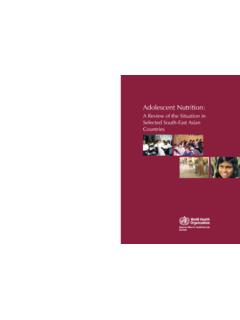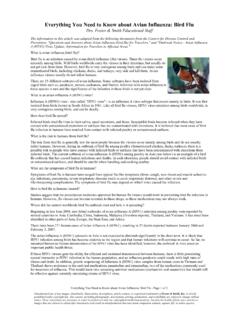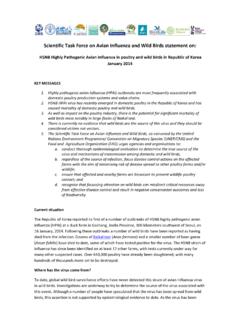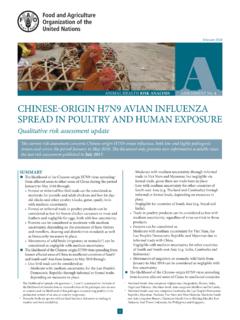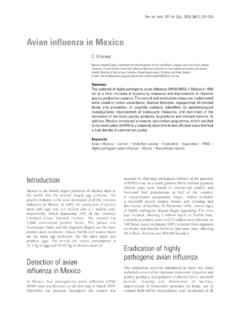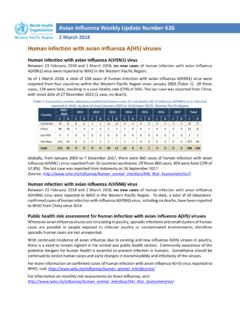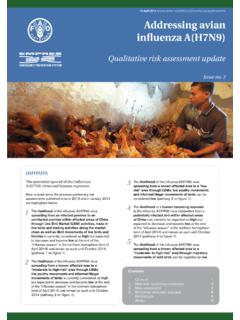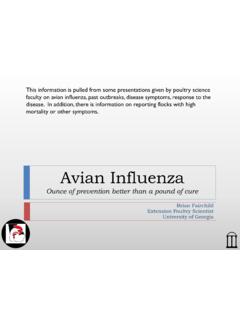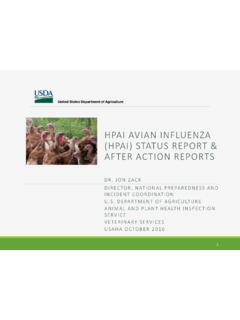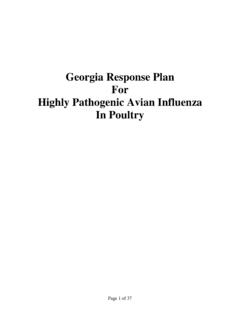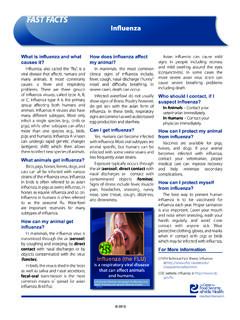Transcription of Avian Influenza - World Health Organization
1 Avian Influenza in South-East Asia Region: Priority Areas for Research SEA/CD/154. Distribution : General Avian Influenza in South-East Asia Region: Priority Areas for Research World Health Organization Publications of the World Health Organization enjoy copyright protection in accordance with the provisions of Protocol 2 of the Universal Copyright Convention. For rights of reproduction or translation, in part or in toto, of publications issued by the WHO Regional Office for South-East Asia, application should be made to the Regional Office for South-East Asia, World Health House, Indraprastha Estate, New Delhi 110002, India. The designations employed and the presentation of material in this publication do not imply the expression of any opinion whatsoever on the part of the Secretariat of the World Health Organization concerning the legal status of any country, territory, city or area or of its authorities, or concerning the delimitation of its frontiers or boundaries.
2 October 2006. Contents Background .. 1. Global and regional situation .. 1. The need for research .. 2. What is known about Avian Influenza .. 2. Evolving virus .. 2. Animal-to-human transmission .. 3. Expanding host range .. 4. Person-to-person transmission .. 5. Antivirals and vaccines .. 6. Potential areas for future research .. 6. Epidemiology .. 6. Laboratory .. 7. Clinical .. 8. Social, behavioural, economic and policy-related issues .. 9. WHO's role in supporting research .. 10. Avian Influenza in South-East Asia Region: Priority Areas for Research iii Background The first cases of human Influenza A H5N1 reported in 1997 from Hong Kong (China) coincided with H5N1 outbreaks in poultry in farms and in wet markets. The destruction of the entire poultry population at that time in Hong Kong (China) resulted in cessation of human cases. In early 2003, however, cases were reported from a Hong Kong (China).
3 Family who had travelled to mainland China. In mid-2003, H5N1 began to circulate in poultry in some countries of South-East Asia and these were followed in December 2003 by human cases in Viet Nam which were followed by subsequent epidemics among poultry in several countries in Asia and human cases in Thailand, Indonesia, Cambodia and China. Global and regional situation Since mid-2005, the spread of Avian Influenza (AI) among poultry across the globe has been rapid with H5N1 outbreaks in birds in 54 countries;. in addition a total of 251 human cases and 148 deaths have been reported from 10 countries across central Asia, Africa, Europe and the Middle East. Two of the 11 countries in the South-East Asia Region Indonesia and Thailand have reported human cases since 2003. Thailand's last human case was reported in September 2006 after no reports for six months.
4 Indonesia continues to report human cases. Thailand and Indonesia account for about 32% of the total global human cases. Outbreaks of H5N1 in poultry have been reported from India and Myanmar in addition to Thailand and Indonesia. Of the current figures for the reported human cases, the case fatality is very high 65%. It is uncertain whether milder cases of human H5N1 infection have occurred. Avian Influenza in South-East Asia Region: Priority Areas for Research 1. The full disease spectrum in man is critical and requires vigilant surveillance. The surveillance system will provide epidemiological, clinical and virological data on Influenza strains. Moreover, efforts have been made to ensure close collaboration between the public Health , agricultural sectors and veterinary services. The need for research There are many unanswered questions about AI H5N1.
5 Research leads to a better understanding of the disease while at the same time developing the evidence base from which to appropriately target effective interventions in the face of limited resources. As part of preparedness, a research agenda has to be prepared because the timing of another pandemic is unpredictable. During the recent AI outbreaks, research on the natural history of the disease has been localized and disjointed. Some data have been available from small-scale investigations but international merging of data has been difficult because of the lack of standardization and compatibility of study protocols. Experiences from the recent H5N1 outbreak and SARS have shown that research on emerging infectious diseases cannot be conducted properly when initiated after the outbreak has occurred. By using an international or regional multi-site research network instead of individual efforts, the necessary capability to understand the disease better can be developed which in turn will help in its prevention and control.
6 In this report, the current knowledge on AI available from studies, and the gaps in knowledge that in order to be filled need the cooperation of all affected countries, have been reviewed and further steps to be taken in this direction recommended. What is known about Avian Influenza Evolving virus The highly pathogenic Influenza A H5N1 virus is endemic in Avian populations in some countries in South-East Asia and represents a real 2 Avian Influenza in South-East Asia Region: Priority Areas for Research pandemic threat. The continued evolution of H5N1, initially a mild disease, has led to a more pathogenic disease in poultry with a risk of mutation or genetic reassortment which can result in a virus with increased transmissibility; the virus survival characteristics have changed, surviving at 37C for 6 days in 2004 compared to 2 days in 1997. Genetically and antigenically distinct sub-lineages of H5N1 virus have become established in poultry in different geographical regions of South- East Asia indicating the long term endemicity of the virus.
7 H5N1 virus has also been isolated from apparently healthy migratory birds in southern China. Animal-to-human transmission The first documented outbreak of human respiratory disease caused by AI A (H5N1) viruses occurred in Hong Kong (China) in 1997. The kinetics of the antibody response to the Avian virus in H5N1-infected persons was similar to that of a primary response to human Influenza A. viruses; serum neutralizing antibody was detected, in general, greater than or equal to 14 days after symptom onset. A study among swine residents and employees in the USA indicated that pig contact was associated with seropositivity to swine Influenza viruses. The study indicated possible risk of transmission from animals to the human population. A. study to evaluate the potential for Avian -to-human transmission of H5N1. was conducted by a cohort study among poultry workers (293 Hong Kong (China) government workers (GWs) who participated in a poultry culling operation and 1525 poultry workers (PWs)).
8 Paired serum samples collected from GWs and single-serum samples collected from PWs were considered to be anti-H5 antibody positive if they were positive by both microneutralization and Western blot testing. Among GWs, 3% were seropositive, and 1 seroconversion was documented. Among PWs, approximately 10% had anti-H5 antibody. More intensive poultry exposure, such as butchering and exposure to ill poultry, was associated with having anti-H5 antibody. These findings suggested an increased risk of AI infection from occupational exposure. A 2004 study in Viet Nam Avian Influenza in South-East Asia Region: Priority Areas for Research 3. among confirmed cases of H5N1 patients identified that in eight of the nine patients in whom history was taken, there was a clear evidence of either direct handling of poultry (chickens and ducks) or exposure to sick poultry in the week before the onset of illness.
9 This study showed exposure to sick poultry as the main risk factor. It also documented an average incubation period of 3 days (range 2-4 days). A 2004 study in Thailand among confirmed cases of H5N1 indicated that all significant risk factors were related to exposure to affected birds, including contact with sick or dead chickens and keeping dead chickens in the house. The study documented an average incubation period of 3 days (range 2-8 days). Molecular biological analysis of viral nucleic acid supports the hypothesis that animals, particularly birds and pigs, may have contributed to earlier Influenza pandemics. Some animal viruses containing genes, H1, H2 and H3, might infect humans directly and become adapted to the human host. Alternatively, reassortment of the genes in different animals or human Influenza viruses might appear in an infectious human virus.
10 Expanding host range The host range is also expanding to include wild and domestic birds and other animals such as cats and tigers. Ducks are a critical factor in highly pathogenic AI (HPAI) persistence and spread; HPAI replicates in respiratory and intestinal tracts of ducks and large amounts are excreted via the respiratory tract and faeces and can spread from ducks to chickens; in Thailand H5N1 was found to be prevalent among free-grazing and backyard ducks compared to ducks raised in areas with high biosecurity. AI can infect not only chickens and ducks but also pigs. Ducks are important because they can be infected with mild or asymptomatic infection and can transmit large quantities of the virus through their excretion and faeces. Pigs are important in crossing the species barrier as they have cell surface receptors for both human and AI viruses.
